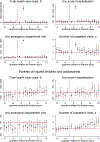Impact of firearm injury in children and adolescents on health care costs and use within a family
- PMID: 37633600
- PMCID: PMC10592083
- DOI: 10.1016/j.ypmed.2023.107681
Impact of firearm injury in children and adolescents on health care costs and use within a family
Abstract
In 2020, firearm injury became the leading cause of death in U.S. children and adolescents. This study examines sequelae of firearm injury among children and adolescents in terms of health care costs and use within a family over time using an event study design. Using data from a large U.S. commercial insurance company from 2013 to 2019, we identified 532 children and adolescents aged 1-19 years who experienced any firearm-related acute hospitalization or emergency department (ED) encounter and 1667 of their family members (833 parents and 834 siblings). Outcomes included total health care costs, any acute hospitalization and ED visits (yes/no), and number of outpatient management visits, each determined on a quarterly basis 2 years before and 3 years after the firearm injury. Among injured children and adolescents, during the first quarter after the firearm injury, quarterly total health care costs were $24,018 higher than pre-injury; probability of acute hospitalization and ED visits were 27.9% and 90.4% higher, respectively; and number of outpatient visits was 1.8 higher (p < .001 for all). Quarterly total costs continued to be elevated during the second quarter post-injury ($1878 higher than pre-injury, p < .01) and number of outpatient visits remained elevated throughout the first year post-injury (0.6, 0.4, and 0.3 higher in the second through fourth quarter, respectively; p < .05 for all). Parents' number of outpatient visits increased during the second and third years after the firearm injury (0.3 and 0.5 higher per quarter than pre-injury; p < .05). Youth firearm injury has long-lasting impact on health care within a family.
Keywords: Children and adolescents; Dynamic impact; Firearm injury; Gun violence; Health care costs and use; United States.
Copyright © 2023 Elsevier Inc. All rights reserved.
Conflict of interest statement
Declaration of Competing Interest None of the authors has any financial interests or relationships relevant to the subject of this manuscript.
Figures


Similar articles
-
Firearm related injuries amongst children: estimates from the nationwide emergency department sample.Injury. 2012 Dec;43(12):2051-4. doi: 10.1016/j.injury.2011.10.040. Epub 2011 Nov 21. Injury. 2012. PMID: 22104700
-
Increases in Actual Health Care Costs and Claims After Firearm Injury.Ann Intern Med. 2020 Dec 15;173(12):949-955. doi: 10.7326/M20-0323. Epub 2020 Sep 29. Ann Intern Med. 2020. PMID: 32986488
-
United States trends in healthcare charges for pediatric firearm injuries.Am J Emerg Med. 2021 Sep;47:58-65. doi: 10.1016/j.ajem.2021.03.046. Epub 2021 Mar 20. Am J Emerg Med. 2021. PMID: 33773299
-
Firearm-related injuries in children and adolescents: an emergency and critical care perspective.Curr Opin Pediatr. 2020 Jun;32(3):349-353. doi: 10.1097/MOP.0000000000000905. Curr Opin Pediatr. 2020. PMID: 32332331 Review.
-
Policy pathways to address American youth firearm injury and death.Ann Fam Med. 2022 Apr 1;20(20 Suppl 1):2726. doi: 10.1370/afm.20.s1.2726. Ann Fam Med. 2022. PMID: 36944041 Free PMC article. Review.
Cited by
-
Firearm Injury Risk Prediction Among Children Transported by 9-1-1 Emergency Medical Services: A Machine Learning Analysis.Pediatr Emerg Care. 2025 Mar 1;41(3):195-202. doi: 10.1097/PEC.0000000000003314. Epub 2024 Dec 12. Pediatr Emerg Care. 2025. PMID: 39665554
References
-
- Lee LK, Douglas K, Hemenway D. Crossing lines—a change in the leading cause of death among US children. N Engl J Med. 2022;386(16):1485–1487. - PubMed
-
- Ranney ML, Herges C, Metcalfe L, Schuur JD, Hain P, Rowhani-Rahbar A. Increases in actual health care costs and claims after firearm injury. Ann Intern Med. 2020;173(12):949–955. - PubMed
MeSH terms
Grants and funding
LinkOut - more resources
Full Text Sources

